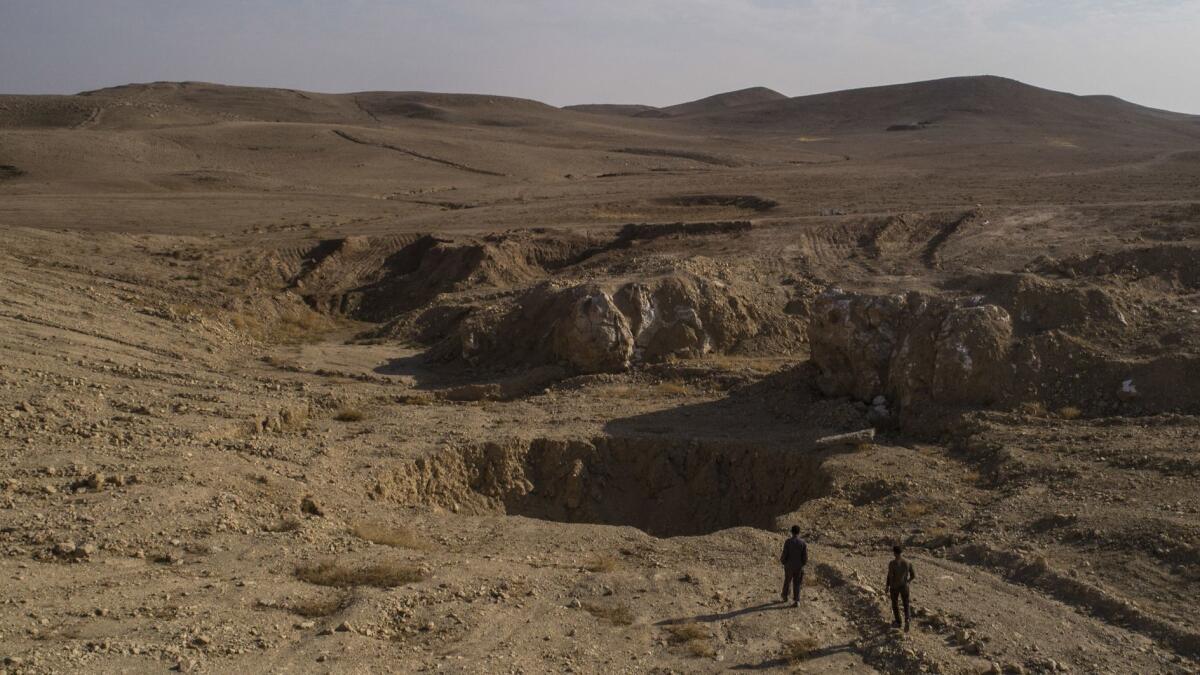Legacy of Islamic State ‘terror’: more than 200 mass graves verified by U.N. in northern and western Iraq

- Share via
Reporting from Washington — From the forlorn resting place of a handful of victims to a huge sinkhole that may contain thousands of bodies, more than 200 mass graves dot the bleak landscape of northern and western Iraq, a testament to the grisly three-year reign of Islamic State, a United Nations report released Tuesday says.
Many of the sites were previously known, but the joint report by the U.N.’s mission to Iraq and the world body’s office for human rights formally verifies the existence of 202 graves, which the investigators describe as evidence of the extremist group’s atrocities that could perhaps someday be used to hold remaining perpetrators to account.
Describing the graves as “large-scale crime scenes,” the report calls the sites part of a “legacy of … terror” by the Islamist militant group, which took control of vast swaths of territory in Iraq and Syria beginning in 2014. The story they tell, it says, is one of “harrowing human loss, profound suffering and shocking cruelty.”
Forensic evidence from the scenes can not only be used to help identify victims, but it also allows investigators to depict the sheer scale of gruesome acts committed by the extremists, who slaughtered civilians en masse and enslaved thousands of Yazidi girls and women before major combat operations to drive them from power concluded in 2017.
“Evidence gathered from these sites will be central to ensuring credible investigations, prosecutions and convictions in accordance with international due process standards,” the report says. “Meaningful truth and justice requires the appropriate preservation, excavation and exhumation of mass grave sites and the identification of the remains of the many victims and their return to the families.”
So far, the investigators have not attempted to pinpoint the total number of victims whose remains bear silent witness to the savagery. The smallest grave site in the report, west of the city of Mosul, contains eight bodies. The largest is a mass grave known as the Khasfa sinkhole, south of the city, which may hold thousands of bodies.
The discoveries date to September 2014, as Islamic State was embarking on its ruthless campaign to establish a Muslim caliphate in a region torn by war since the U.S.-led invasion of Iraq in 2003.
The first grave to be documented was found on the road to the Mosul dam outside the city and contained the bodies of 14 civilians, all thought to be Yazidi. Ten were men, one a woman, and three were children.
As time went on, the massacres — and the graves left behind — grew larger, the report says.
Most of the sites lie close to Mosul, the largest Iraqi city to fall under Islamic State’s sway, and in the Sinjar area that is home to the Yazidis, a minority religious group.
Islamic State’s “horrific crimes in Iraq have left the headlines, but the trauma of the victims’ families endures, with thousands of women, men and children still unaccounted for,” said Michelle Bachelet, the U.N.’s high commissioner for human rights. She cited the militant group’s “twisted ideology and rule” that singled out ethnic and religious minorities, marking them for death or enslavement.
“Their families have the right to know what happened to their loved ones,” Bachelet said. “Truth, justice and reparations are critical to ensuring a full reckoning” for crimes committed by the group, whose acts have been described by the U.N. as a possible genocide.
Some of the graves could yield new information about well-known mass crimes, such as Islamic State’s 2014 killing of about 1,700 captive Iraqi security forces and army cadets at Camp Speicher near Tikrit, about 100 miles north of Baghdad. In that massacre, Shiite Muslims and other minorities were targeted by the Sunni Muslim militants for execution.
Sometimes, rather than digging graves, the killers threw bodies into existing wells or sinkholes, making little effort to cover and conceal them.
It was nearly a year ago — December 2017 — when U.S.-backed Iraqi forces declared victory over Islamic State. But the militants still hold some territory in Syria and continue to stage attacks in Iraq, including kidnappings and bombings.
More graves are likely to be discovered, and some of those already known have not yet been dug up — in certain cases because they contain bombs and other hazards. The U.N. estimated at one point that Islamic State had killed about 30,000 people between 2014 and 2017. But so far, only 1,258 bodies have been exhumed from 28 sites, a fraction of the expected total.
More to Read
Sign up for Essential California
The most important California stories and recommendations in your inbox every morning.
You may occasionally receive promotional content from the Los Angeles Times.













